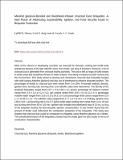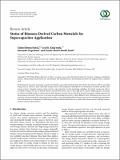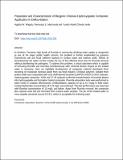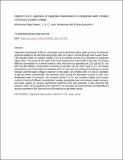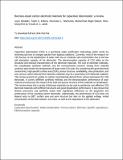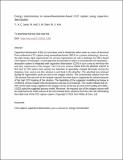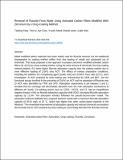Search
Now showing items 1-10 of 69
Biogas-slurry derived mesoporous carbon for supercapacitor applications
(Elsevier Ltd., 2017-09)
This study reports on the transformation of biogas slurry into mesoporous carbon for supercapacitor electrodes. Pore structures have been modified by altering activation time, temperature and KOH/carbon mass ratio. The ...
Manihot glaziovii-Bonded and Bioethanol-Infused Charcoal Dust Briquettes: A New Route of Addressing Sustainability, Ignition, and Food Security Issues in Briquette Production
(Springer Nature Switzerland AG, 2019-11-22)
Most of the citizens in developing countries use charcoal for domestic cooking and small-scale enterprises because of its high calorific value, less smoke, and easy to transport. However, a lot of charcoal dust is generated ...
Status of Biomass Derived Carbon Materials for Supercapacitor Application
(Hindawi, 2017-01-31)
Environmental concerns and energy security uncertainties associated with fossil fuels have driven the world to shift to renewable energy sources. However, most renewable energy sources with exception of hydropower are ...
Preparation and Characterization of Biogenic Chitosan-Hydroxyapatite Composite: Application in Defluoridation
(Cambridge University Press, 2018-02-20)
In Northern Tanzania, high levels of fluoride in community drinking water supply is recognized as one of the major public health concern, the problem is further ameliorated by presence Escherichia coli and fecal coliform ...
Hybrid CV-CC operation of capacitive deionization in comparison with constant current and constant voltage
(Taylor & Francis Online, 2016-02-24)
Capacitive deionization (CDI) is a technique used to desalinate saline water by means of electrical potential applied to the electrode along both sides of a spacer channel through which water flows. CDI operates either at ...
Biomass-based carbon electrode materials for capacitive deionization: a review
(Springer Nature Switzerland AG., 2019-06-27)
Capacitive deionization (CDI) is a promising water purification technology which works by removing salt ions or charged species from aqueous solutions. Currently, most of the research on CDI focuses on the desalination of ...
Energy minimization in monoethanolamine‐based CO2 capture using capacitive deionization
(John Wiley & Sons, Ltd., 2014-01-07)
Post‐combustion CO2 capture using monoethanolamine (MEA) is a mature technology; however, the high energy input requirements for solvent regeneration are still a challenge for MEA‐based CO2 capture. In this paper, a novel ...
Removal of fluoride from water using activated carbon fibres modified with zirconium by a drop-coating method.
(Elsevier Ltd, 2020-09-01)
Metal-modified carbon materials have been widely used for fluoride removal, but the traditional impregnation by soaking method suffers from low loading of metals and substantial use of chemicals. This study proposed a new ...
Modification strategies to enhance electrosorption performance of activated carbon electrodes for capacitive deionization applications
(Elsevier, 2019-09-01)
Capacitive deionization (CDI) is the competitive technology for water desalination which appears to become an alternative to conventional methods such as ion exchange resins, reverse osmosis, and electrodeionization. Variety ...
Combined reverse osmosis and constant-current operated capacitive deionization system for seawater desalination
(Elsevier B.V., 2014-07-01)
There is an increase in the use of water purification technologies to produce the purified water from saline water. The desalination process may either involve the use of a single desalination technology, or may include ...


